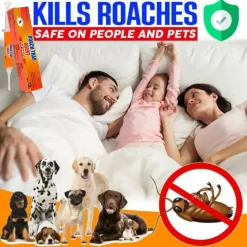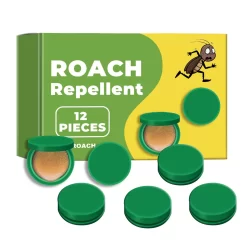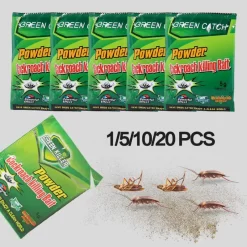Cockroaches, those resilient survivors, have been around for millions of years. Their toughness and adaptability make them a formidable foe, but with the right approach and professional tools, you can effectively eliminate them.
-33%
£29.99 – £54.99
This product has multiple variants. The options may be chosen on the product page
-31%
£24.99 – £34.99
This product has multiple variants. The options may be chosen on the product page
-43%
£19.99 – £39.99
This product has multiple variants. The options may be chosen on the product page
Early Warning Signs of a Cockroach Infestation
If you're dealing with cockroaches or suspect you might be, knowing the early warning signs can help you take action before a minor problem turns into a full-blown infestation. Even if you’ve already treated your home or workplace, staying alert to these signs is essential to ensure you’ve completely eradicated them.1. Eggs and Shed Skins
Cockroaches lay eggs in cases called oothecae, and as they grow, they shed their skins. You’re likely to find these eggs and skins around food sources or hidden in dark corners. The eggs are sometimes glued to surfaces like walls, so check behind furniture and under shelves for these telltale signs.2. Droppings
Cockroach droppings can be a clear indication of an infestation. Their droppings come in two forms: small black or brown pellets if they’ve had little access to water, and brown smears if they’re better hydrated. Noticing a large amount of either type of droppings can give you a good idea of how severe your infestation is.3. Damage
Cockroaches aren’t picky eaters. While they’re drawn to food waste, they’ll chew through paper, cardboard, wood, fabric, rubber, and even plaster. If you notice unexplained damage to items in your home—whether it’s books, carpets, or wallpaper—it could be a sign that cockroaches have been feeding.4. Odors
One of the lesser-known signs of a cockroach problem is a musty, stale smell. As cockroaches multiply, they release a distinct odor that intensifies as the infestation grows. This scent serves as a form of communication for them, signaling to other roaches that a particular area is a good hiding spot. The stronger the smell, the larger the infestation is likely to be.5. Using Cockroach Traps
If you occasionally spot cockroaches, don’t assume they’re just passing through. Seeing one can indicate that their hiding spots are overcrowded, which means you may have a serious issue. Setting cockroach traps near suspected infestation areas can help you gauge the severity of the problem. Most traps use a combination of a sticky surface and bait to lure and catch cockroaches, allowing you to monitor how many are present. If traps start filling up quickly, it's time to take more aggressive measures.6. Flushing Agents
Flushing agents are useful for confirming an infestation when you suspect bugs are hiding out of sight. These products contain insecticides that drive cockroaches out of their hiding places, giving you a clearer view of the extent of the problem. Once applied behind furniture, in cracks, or any suspected area, the delayed action of the insecticide forces cockroaches into the open before they’re killed.Common Cockroach Species You May Encounter
Although there are thousands of cockroach species worldwide, in the UK, only a few are common. Here are the ones you’re most likely to encounter:- German Cockroach Light-colored with two dark stripes on its head, this species is the most common in the UK. They thrive in damp areas, making kitchens and bathrooms their preferred locations.
- American Cockroach Known for being the largest UK cockroach, they grow up to 30 cm in length and are dark reddish-brown. They are typically found in hot, humid environments like cellars and near heating pipes.
- Oriental Cockroach These roaches are large and dark brown or black, often living in sewers. They can find their way into homes through drains, making kitchens and basements common sites of infestation.
- Brown-Banded Cockroach Small and distinct with brown markings, these cockroaches prefer drier conditions and are often found in attics or behind bedroom furniture.
Preventing Cockroaches from Returning
To keep cockroaches at bay, maintaining cleanliness is crucial. Cockroaches are attracted to food waste, dirt, and stagnant water. Here are some tips to reduce the chances of them returning:- Keep surfaces clean: Wipe up food crumbs and spills in your kitchen promptly.
- Properly store food: Ensure that food is sealed tightly, especially items that cockroaches find attractive like sugary snacks.
- Eliminate water sources: Cockroaches need water to survive, so fix any leaks, regularly change pet water bowls, and don’t leave wet towels or sponges lying around.
- Seal entry points: Cockroaches can enter through small cracks or gaps, so inspect your home for potential entryways and seal them up.






